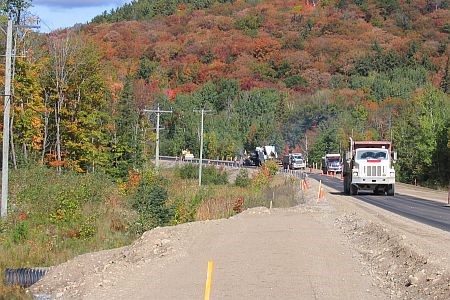Big-ticket investments and existing provincial commitments are giving hope to some Northern Ontario road builders who anxiously await word from the province about its plans for the upcoming year.
Big-ticket investments and existing provincial commitments are giving hope to some Northern Ontario road builders who anxiously await word from the province about its plans for the upcoming year.
“With the stimulus money for infrastructure that’s coming, we’re expecting to see another really good year for the business,” says Marcel Labelle, president of the Cochrane-based
M.J. Labelle Co. Ltd.
“Some people may disagree, but things are looking pretty positive.”
Founded by Labelle in 1955, the business has handled countless road construction jobs through the years, focusing mainly in recent years on road repair and upgrade work in the northeast.
Last summer, M.J. Labelle Co. Ltd. employed upwards of 100 people, with projects including two separate jobs on Highway 101 junctions by Matheson and Porcupine. Despite the great hope being held out for 2010 through impending provincial projects, the bulk of the funding announcements for road-building projects is not expected until the advent of the provincial budget at the end of March.
As such, the company is shoring up its project list by doing municipal upgrading work in Cochrane, as well as projects for the forestry and mining industry. These include access roads for exploration firms and tailing ponds for active miners.
This kind of proactive approach is wise as the province is likely to begin scaling back on its spending on Northern Ontario highways in the near future, says Rob Bradford, executive director of the
Ontario Road Builders Association.
Although road budgets have risen in recent years, they will move back to more normal levels once the stimulus funding for infrastructure dries up and the four-laning of Highway 69 wraps up in 2017, says Bradford. This would be a mistake, he says, given that Ontario is quite easily “billions and billions of dollars” behind on maintaining its roads.
“We’re all on pins and needles on what’s going to happen two, three years from now when governments in their wisdom say that the stimulus stuff is done and the infrastructure thing is over and we can move on,” says Bradford. “We’ve got to implant the feeling in their mind that what they’ve done here is what they needed to do all along. Economic stimulus aside, they’re not even beginning to catch up to the infrastructure deficit so they’ve got to keep this kind of investment up over the long term.”
In 2009, Northern Ontario roadwork reached $648 million, or 41 per cent of the provincial total of $1.8 billion in highway construction, due in part to investment through the province’s Northern Highways Program. This has been an “unprecedented” share of road totals for the North, which traditionally only makes up 25 per cent of the annual roads budget, says Bradford. Bridge work is also expected to be big in the coming years, with 59 new bridges needed for the North as mapped out in the
Ministry of Transportation’s (MTO) 2009-2013 construction plans, he adds.
There are similarly high expectations for municipal projects through stimulus-funded initiatives, though many around the North have remained tight-lipped about their intentions for the 2010 season, says Bradford. Some exceptions to that rule include the City of Greater Sudbury, which has outlined plans to kick off a year of record-breaking investment in municipal roadbuilding. At $74 million, the city’s road-building budget encompasses work to several major areas of the community.
This doesn’t include specific projects the city would like to see which remain unfunded, such as the proposed 11-kilometre extension to Maley Drive, designed to relieve intensifying local traffic.
Nearly half the city’s 2010 road-building funding arrives from provincial and federal stimulus sources, something which Bradford says is going to generally lift the fortunes of construction firms through the next year or two.
